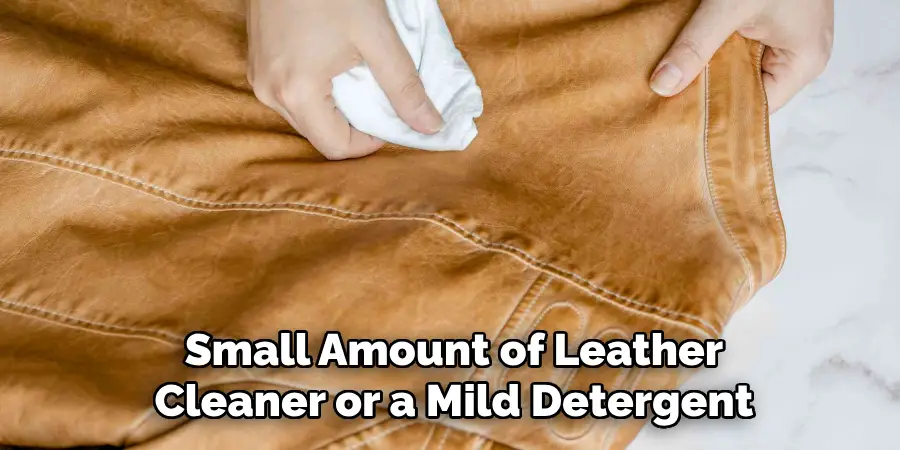Are you tired of taking your leather jacket to a dry cleaner whenever it needs cleaning? Well, worry no more! You can easily clean your leather jacket in a washing machine at home with the right techniques and products.

Cleaning a leather jacket can be daunting, especially when considering using a washing machine. Leather is a delicate material that requires special care to maintain its quality and longevity. However, with the right approach and proper precautions, cleaning your leather jacket in a washing machine is possible without causing damage.
This guide on how to clean a leather jacket in washing machine will walk you through the necessary steps to ensure your jacket comes out fresh and unharmed while retaining its original look and feel.
What Are the Benefits of Cleaning a Leather Jacket in Washing Machine?
Cleaning your leather jacket in a washing machine has several benefits, some of which are listed below:
- Convenience: Taking your leather jacket to a dry cleaner can be time-consuming and expensive. By cleaning it at home, you save both time and money.
- Proper Cleaning: Dry cleaners may not have the expertise or products to clean leather properly. Doing it yourself ensures that your jacket is cleaned thoroughly with appropriate products.
- Maintaining Quality: Regularly cleaning your leather jacket helps maintain its quality and prolongs its lifespan. A washing machine can effectively remove any dirt or stains without causing damage to the material.
What Will You Need?
Before you start cleaning, ensure you have all the necessary items ready. Here’s a list of things you will need to clean your leather jacket in a washing machine:
- Leather cleaner or mild detergent
- Soft-bristled brush or sponge
- Clean towel
- Garment bag or pillowcase (optional)
Once you have all these items, you are ready to begin!
8 Easy Steps on How to Clean a Leather Jacket in Washing Machine
Step 1. Prepare the Jacket:
Begin by inspecting your leather jacket for any visible dirt, stains, or areas that require extra care. Use a soft-bristled brush or sponge to remove dust or loose debris from the surface gently. Pay special attention to seams, pockets, and folds where dirt accumulates. If there are any stubborn stains, pre-treat them with a small amount of leather cleaner or a mild detergent. Apply the cleaner sparingly and gently blot the area with a clean towel until the stain lightens. Allow the pre-treated spots to dry completely before moving forward.

Additionally, check for any care labels or manufacturer instructions inside the jacket, as they may provide specific cleaning guidelines or warnings. If the jacket has embellishments like zippers, buttons, or decorative elements, ensure they are secured or covered to prevent damage during the washing process. Finally, if you are concerned about direct contact with the washing machine, consider placing the jacket inside a garment bag or pillowcase for added protection.
Step 2: Washing the Jacket
Once the jacket is prepared, set the washing machine to a gentle or delicate cycle with cold water to prevent damage to the leather or fabric. Use a mild detergent specifically designed for delicate materials or leather-safe formulas. Avoid using bleach or harsh chemicals, as these can deteriorate the material. Place the jacket in the machine, ensuring it has enough space to move freely during the wash. If you use a garment bag or pillowcase, ensure it is securely closed. Monitor the wash cycle closely, and remove the jacket as soon as it is finished to avoid excessive soaking or wrinkling.
Step 3: Drying the Jacket
After washing, remove the jacket from the washing machine and gently shake it to remove excess water. Avoid wringing or twisting the coat, damaging its shape or material. Lay the jacket flat on a clean, dry towel, and roll the towel gently to absorb additional moisture. Once most of the water has been removed, place the jacket on a flat surface in a well-ventilated area to air dry. Avoid direct sunlight or high heat from dryers, as these can cause shrinking, discoloration, or cracking in leather. Periodically reshape the jacket during the drying process to maintain its original form. Consider applying a leather conditioner once dry for leather jackets to restore flexibility and prevent cracking.
Step 4: Storing the Jacket
Proper storage is essential to maintaining the longevity and appearance of your jacket. Always store the jacket in a cool, dry place away from direct sunlight or humid conditions, which can lead to fading, mold, or mildew. Use a sturdy, padded hanger to retain the jacket’s shape and prevent creases. Avoid using plastic covers, as they can trap moisture, and opt for a breathable garment bag if protection is needed. Regularly inspect your jacket during storage to ensure it remains in good condition.
Step 5: Repairing Minor Damage
Over time, leather jackets can develop minor scratches or scuffs. To address these imperfections, gently clean the affected area with a damp cloth and allow it to dry completely. Once dry, use a leather repair cream or balm in a matching color to blend and restore the surface.
Apply the product sparingly with a soft cloth, buffing it in circular motions until the scratch becomes less noticeable. For more significant damage, consult a professional leather repair service to avoid causing further harm to the material. Regular maintenance can help minimize wear and keep your jacket looking its best for years.

Step 6: Cleaning the Lining
The lining of a leather jacket can accumulate dirt, sweat, and odors over time, requiring periodic cleaning. To clean the lining, turn the jacket inside out and gently spot-clean the fabric using a damp cloth with a mild detergent or a fabric-safe cleaning solution. Focus on areas that come into direct contact with skin, such as the underarms and collar. Avoid soaking the material, and let the jacket air dry completely before returning it to its original shape. Proper care of the interior lining helps maintain overall freshness and extends the life of your leather jacket.
Step 7: Keep it Away from Heat
Exposure to direct heat sources can cause significant damage to your leather jacket. Heat can dry out the leather, making it brittle and prone to cracking. Therefore, avoid placing your jacket near radiators, fireplaces, or other heat-emitting appliances. For drying after cleaning or exposure to light rain, always allow the coat to air dry naturally in a shaded, well-ventilated area. Never use a hairdryer or tumble dryer, as the concentrated heat can harm the leather’s texture and finish.
Step 8: Professional Leather Cleaning
Professional leather cleaning is the safest option if your leather jacket is heavily soiled or stained or if you’re unsure about cleaning it yourself. Expert leather cleaners have specialized equipment and treatments designed to remove dirt and restore your jacket without causing any damage.
They can address tough stains, discoloration, or odors that may not be removable through at-home methods. Taking your jacket to a professional at least once a year or whenever it requires deep cleaning is recommended. Make sure to research and choose a reputable cleaner familiar with dealing with leather garments to ensure the best care for your jacket.

By following these steps and regularly cleaning and maintaining your leather jacket, you can extend its lifespan and keep it looking stylish for years.
5 Things You Should Avoid
- Using Harsh Detergents: Harsh detergents can strip the natural oils from the leather, leading to dryness and cracks. Always avoid using bleach-based or strong chemical detergents on leather materials.
- Skipping the Gentle Cycle: Leather requires delicate handling, and using a regular or heavy-duty cycle can damage the jacket’s texture and shape. Always opt for the gentlest cycle if you attempt this method.
- High Water Temperature: Hot water can cause the leather to shrink, warp, or even lose its natural sheen. Stick to cold or lukewarm water to minimize potential damage.
- Using a Dryer: Placing a leather jacket in the dryer can ruin its form and cause the leather to harden or crack. Air dry the coat in a shaded area instead of exposing it to high heat.
- Skipping Testing on a Small Area: Failing to test cleaning products or methods on a small, inconspicuous leather part before washing the entire jacket can result in irreversible damage. Always test to ensure compatibility with the material.
By avoiding these common mistakes, you can keep your leather jacket in top condition and enjoy it for many years.

Conclusion
How to clean a leather jacket in washing machine is a delicate process that requires careful attention and adherence to best practices. While possible, it should only be done as a last resort and with the proper precautions in place.
Always use a gentle cycle and cold water, apply suitable leather-friendly cleaning products, and avoid high heat during washing and drying. Testing products on a small, hidden jacket area beforehand can prevent unexpected damage. By handling the process with care and patience, you can safely refresh your leather jacket while maintaining its quality and longevity.
Hopefully, this guide has provided you with the information and tips to successfully clean your leather jacket at home or choose the best professional cleaning service for your needs. So, keep up with regular maintenance and enjoy the timeless appeal of a well-maintained leather jacket! Happy cleaning!

